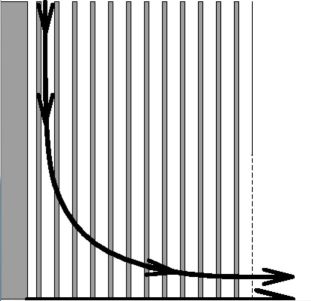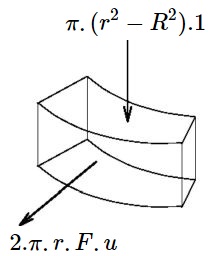

Let's proceed with the equations for Heat Transfer in the fluid tube continuum,
as they have been presented in the previous section.
To begin with, the heat transfer equations can be integrated exactly at
the less interesting part of the tube bundle, where the flow streams parallel
to the tubes and thus is no longer two-dimensional. For that mid-bundle area,
a so-called one-tube model can be employed, which turns out to be a system of
two coupled ordinary differential equations. Such a system can be solved by
standard means. There is nothing new here.
But, apart from the parallel flow area, analytical solutions can be found for
some other places in the heat exchanger. Such a solution can be constructed
rather easily for a streamline which runs from the join between the central
tube and the lower tube plate towards the outflow perforation:

The equations there reduce to an ordinary differential equation for primary temperatures, because the secondary temperature is a boundary condition. In addition, we have an expression for the flow distribution in place, according to the TA/K model. Substitution of the latter into the Heat Transfer equation for the Primary medium leads to: $$ c.G_P.\frac{1}{2.F} \left( r - \frac{R^2}{r} \right) \frac{dT_P}{dr} + a.[ \, T_P - T_{S0} \, ] = 0 $$ The solution of such an ordinary differential equation is routinely found with Operator Calculus: $$ \left[ \frac{d}{dr} + \frac{2.r.F.a/(c.G_P)}{r^2 - R^2} \right] (T_P - T_{S0}) = 0 $$ The following term must be integrated: $$ \int \frac{2.r.F.a/(c.G_P)}{r^2 - R^2} \, dr = \frac{F.a}{c.G_P} \int \frac{dr^2}{r^2 - R^2} = \frac{F.a}{c.G_P} \ln \left( \frac{r^2}{R^2} -1 \right) $$ Herewith, the differential equation is transformed into: $$ \left( \frac{r^2}{R^2} -1 \right)^{ - F.a/(c.G_P) } \: \frac{d}{dr} \: \left( \frac{r^2}{R^2} -1 \right)^{ + F.a/(c.G_P) } \: (T_P - T_{S0})= 0 $$ And the solution of it is: $$ T_P - T_{S0} = K.\left( \frac{r^2}{R^2} -1 \right)^{ - H } \quad \mbox{where} \quad H = F.a/(c.G_P) $$ Furthermore, $K$ is a (rather) unknown constant. Because $(r^2/R^2 - 1)$ becomes zero in the corner for $r=0$ and the quantity $-H$ is a negative power, it must be concluded that the solution is singular. Well, of course not ! Infinities of this nature cannot exist, at all, in a heat exchanger.
There are no black holes
in a simple chemical apparatus. On physical grounds, we can be absolutely certain
that all temperatures
are in between the following bounds: $T_{S0}$, the secondary inlet-temperature
and $T_{PL}$, the primary inlet-temperature. Therefore we must conclude that
the constant $K$ can be nothing else but zero. As a consequence herefrom, along
the streamline at the bottom of the apparatus: $T_P = T_{S0}$. Meaning that
the primary temperature is equal to the secondary inlet-temperature everywhere
at the lower tube plate.
But now it seems that we have gone a bit too far. To refresh our memory, the
fluid tube continuum model is meant to be a crude model of a discrete
reality. Therefore we should always put question marks at the validity of the
model. Especially, attention is required as soon as singularities become
apparent in the model. Spots at which singularities occur are suspect without
question. Infinities cannot physically exist anyway. But instead of assigning
immediately the null-solution, we should think of another possibility.
A singularity can also be a signal that our continuum hypothesis is no
longer a valid assumption, for certain spots in the model. It is clear that,
with the fluid tube continuum model, the solution is an approximation only for
infinitesimal volumes with a size greater than the pitch between tubes. If we
smear out the solution over a ring with size $s$ (of the pitch), then it should
approximately be the same solution again. Let this be exemplified for our
abovementioned analytical solution (where it is assumed for convenience that $H \neq 1$):
$$
K.\frac{ \int_{x}^{x+s} \left[ \, (r/R)^2-1 \, \right]^{-H}
\, 2.\pi.r.dr }{ \pi.[ \, (x+s)^2 - x^2 \, ] } = $$ $$ \frac{K}{1-H}.
\frac{ \left[ \left( \frac{x+s}{R} \right)^2 - 1 \right]^{1 - H} -
\left[ \left( \frac{x}{R} \right)^2 - 1 \right]^{1 - H} }
{ \left( \frac{x+s}{R} \right)^2 - \left( \frac{x}{R} \right)^2 }
$$
Here $s=$ the pitch of the tube bundle; $H = F.a/(c.G_P)$.
Quite another picture is emerging now. The singularity becomes weakened
by smearing it out over the pitch. Two distinct cases can be distinguished:
It is a nice exercise to actually calculate this critical mass flow for a real world heat exchanger, which happens to be the Neratoom IHX (Intermediate Heat Exchanger). The IHX was meant to operate in the hot leg of a Liquid Metal Fast Breeder Reactor (LMFBR), namely SNR-300 in Kalkar, West-Germany.
program test;The outcome is : $G_P = 215.6 \, kg/s$ . The fine structure of the IHX tube bundle may have been observable, since large scale physical experiments , with primary mass flows varying between $80$ and $360 \, kg/s$, have been actually carried out in a test facility. And our calculated value of the critical mass flow is clearly in that range. Thus the discrete substrate of the fluid tube continuum could have been visible as such.
function critical : double; const NP : double = 846 ; { number of tubes } DO : double = 0.0210 ; { outer diameter of tubes } DI : double = 0.0182 ; { inner diameter of tubes } L : double = 20 ; { conductivity of tube walls } F : double = 0.370 ; { height of outflow perforation } C : double = 1275; { heat capacity of sodium } var A : double; { heat transfer coefficient } begin A := NP*2*Pi*L/ln(DO/DI); critical := F*A/C; end;
begin Writeln(critical:4:1,' kg/s'); end.